The breakfast buffet at the Cairo hotel was definitely better-stocked than the one on the motorboat, but we did not have time to linger. I was more than a bit giddy because today was the great day. The traffic was horrible, but as we were stuck there, we caught our first sight at the pyramids! The haze and smoke over Cairo [القاهرة] are thick in the morning, so instead of heading directly to Giza, we turned our back from it and drove off towards Saqqara [سقارة]. Both Saqqara and Giza are part of the Unesco World Heritage site Memphis and its Necropolis – the Pyramid Fields from Giza to Dahshur.
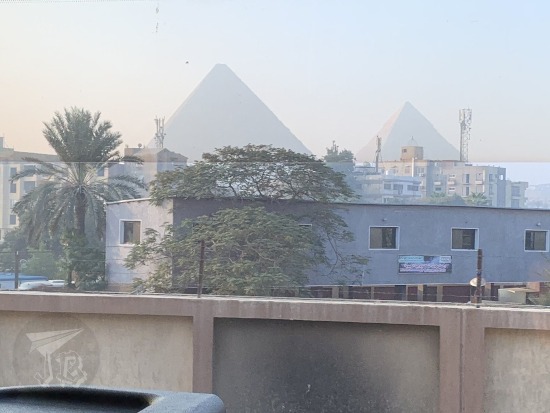
Memphis was the capital of Ancient Egypt during the Old Kingdom, for eight dynasties. It flourished during the Sixth Dynasty (24th – 22nd centuries BCE), but started a decline at the beginning of the Eighteenth Dynasty (16th – 13th centuries BCE), first in favour of Alexandria, then of Thebes (Luxor). If Memphis was the city of the living, Saqqara was its city of the dead, the cemetery.
The Necropolis of Saqqara [أهرامات سقارة] starts off right at the end of the area where the fertile land from the Nile ends, so you cross from a date palm forest to a scorching dry desert. The burials there predate the Old Kingdom, and the oldest tombs belong to the Second Dynasty, and here the first pyramid was built. The timeline for burials was Abydos (which we did not get to see) → Saqqara → Giza (both of which we would see that day) → Valley of the Kings.
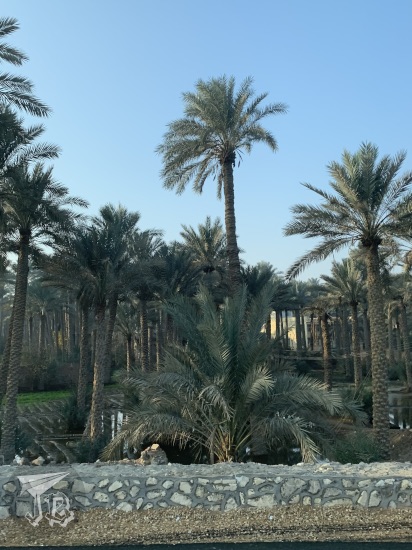
Our first stop was the Necropolis of Teti. Teti was the first king of the Sixth Dynasty (24th century BCE) in the Old Kingdom, back in the time when the Egyptians had started working on elaborate burial sites. Thus, he had a pyramid complex for himself, his queens and officials.
Teti’s vizier (and probably son-in-law) Kagemni was buried in the necropolis. The type of funerary monument built for him was a mastaba. A mastaba [مصطبة] is type of burial, maybe a precursor of the pyramids – it is a rectangular structure with inward sloping walls built using mud bricks. They remained common among non-royals for over a thousand years after Kings were buried in pyramids.
Thus, we went into the Mastaba of Kagemni, vizier to King Teti of the Old Kingdom. The inner walls of the mastaba are decorated with coloured carvings of every day’s life, and mourning scenes for the deceased. There are lots of fishing scenes, featuring hippopotamuses, crocodiles, catfish… and cattle rearing work.
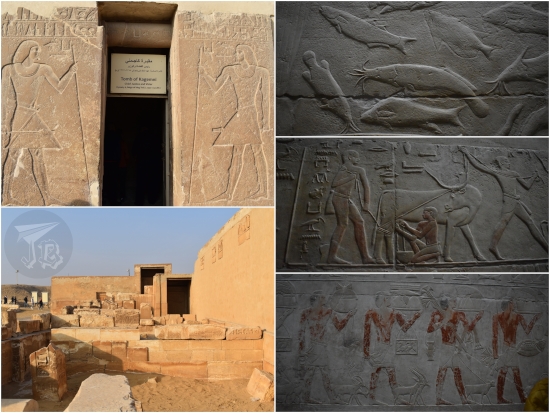
After the vizier’s tomb, we went into our first pyramid, the Pyramid of Teti [هرم تتي] himself. The pyramid today looks just like a hill from the outside – under all the rubble there is a big pyramid, along with three smaller ones, and a funerary temple. The pyramid was opened in 1882, and despite the poor condition of the above-ground area, the corridors and chambers inside very are well-preserved. This pyramid is one of the first ones with carved funerary texts – a number of rituals and spells called the Pyramid Texts. The entrance to the structure is downwards. A ramp leads into a narrow and low corridor which ends in a vestibule that in turns opens into three small chambers to the left, and the mortuary chamber to the right. The King’s sarcophagus remains at the pyramid, with carvings inside – the first carved sarcophagus ever found.

I am not sure I can describe the high that I felt when I went inside the pyramid. It was like breathing history. Unfortunately, we had to move on too quickly. Fortunately, there were more things to discover! We got out of the bus to see the line of three pyramids – Pyramid of Unas, the Step Pyramid of Djoser, and the Pyramid of Userkaf.
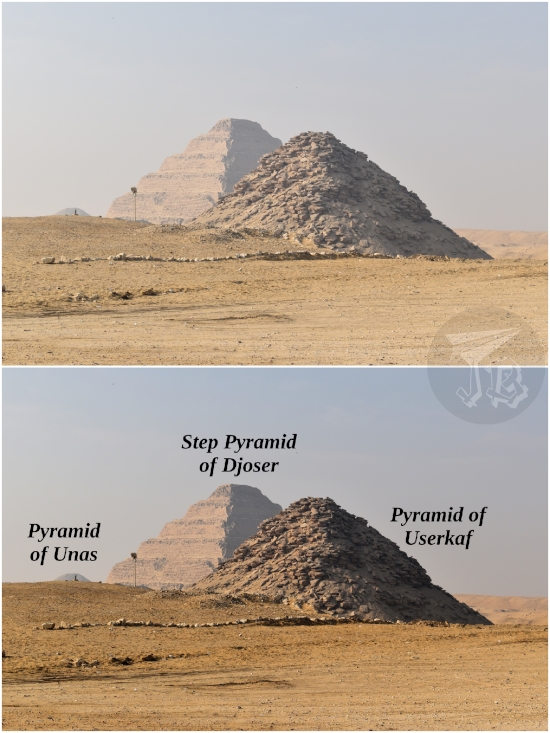
Djoser was either first or second king of the Third Dynasty of the Old Kingdom, sometime around the early 27th century BCE. His architect Imhotep is credited with the design of what possibly was the first ever pyramid. Djoser Mortuary Complex comprises the enclosure wall with a colonnaded entrance, a number of Heb Sed chapels, where dedicated priests honoured the different gods of Ancient Egypt. The roofed chapel area opens into a large patio, which used to be surrounded by a mud brick wall – today only the entrance stands, having been recently restored. In the middle of the open court, stands the Step Pyramid of Djoser [الهرم المدرج للملك زوسر].
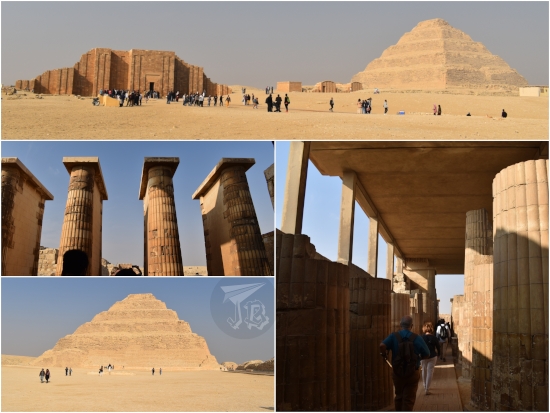
The Pyramid of Userkaf [هرم أوسركاف] was built for the founding pharaoh of the Fifth Dynasty (25th century BCE, Old Kingdom). The pyramid and all the surrounding funerary structures were pillaged in antiquity, and time has taken its toll – the structure is a core of rubble that looks like a huge anthill.
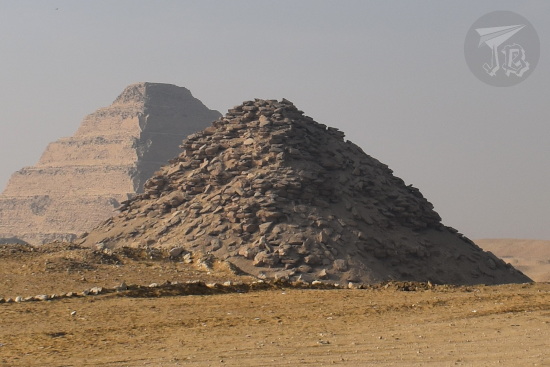
The Pyramid of Unas [هرم أوناس] is even more decayed. Unas was the last king of the Fifth Dynasty (24th century, Old Kingdom), and his is the smallest pyramid of the Old Kingdom, but the first ever in which funerary texts were inscribed. Some of the outer casing is still visible, and there are also some remains of the mortuary temple in front of the pyramid, but most of the complex it is unstable rubble. Nevertheless, I’m a bit sad we did not get to go in and see the texts.
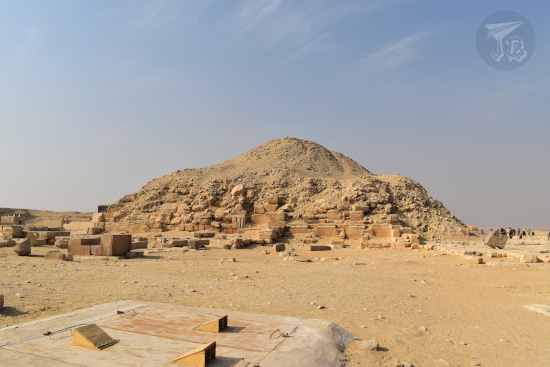
We overlooked the New Kingdom Tombs and the Persian Shafts, tombs of the high officials in Persian Egypt between the 6th and 5th centuries BCE. The tombs are connected together underground, but again, we only saw them from the outside.
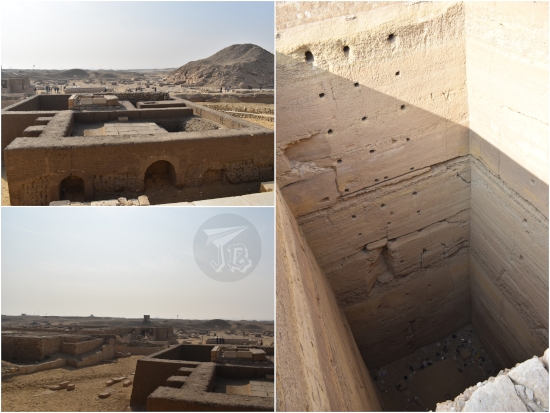
We went back to the coach and were shown to a carpet / tapestry “school” which was a bit unsettling as it felt like a cover for children’s work. Then we drove off back towards Cairo and Giza [الجيزة], where we ran into a ten-lane traffic jam. However, we eventually made it to The Pyramids of Giza Archaeological Site [مجمع أهرامات الجيزة].
The tour guide had been trying to talk us out of stepping into any Giza pyramid claiming that “all of them are the same”, and we had already been inside one in Saqqara. This time, however, we did not buy into his “recommendation”. Part of the group wanted to go in, and of course I was among them – I might have been a bit worried about claustrophobia, but I did not want to miss the experience. All of us chose to enter the Great Pyramid of Giza [الهرم الأكبر], attributed to the pharaoh Khufu, aka Cheops, the second pharaoh of the Fourth Dynasty (26th century BCE, Old Kingdom). The pyramid stands 137 m high, nine lower than when it was built, due to 46 centuries’ worth of wind erosion. At the time of construction, it was the highest man-made structure, and it remained so for almost 4,000 years, until in 1647, it had eroded to 139 m, slightly lower than the Strasbourg Cathedral in France (142 m, built in 1439). Ancient Egyptians used 2.3 million large blocks that total to 6 million tonnes in weight.
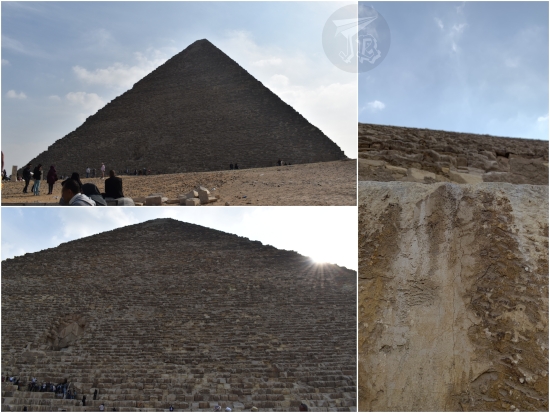
We were lucky enough to start queuing for entry during “lunch break” so we did all our little climb without sharing the space with anyone climbing down in the opposite direction. First, we went up the outside of the pyramid towards the entrance, then we went inside. There was a narrow, tear-shaped corridor, then you start the actual climb through a 1 m x 1.3 m passageway that ascends 40 m to the Great Gallery, which is also narrow, an extra 47 m upwards and 8.5 m high. And finally, we reached the King’s Chamber with the sarcophagus, dead in the middle of the pyramid. For a few minutes, we had the chamber for our little group, which was even better. When we were ready to leave we went our way down and did not cross many people either. The emotions I felt being there, inside the Great Pyramid, were amazing. I know it is not reasonable, but the feeling was exhilarating. It was being inside history, 46 centuries of it. It was just awesome, in the literal sense of the word.

Afterwards, we went back to the coach, which drove us around the complex so we had a view of the pyramids from one of the Panoramic View of the Pyramids points. There, we got to hang out for about 20 minutes as part of the group took a dromedary trip. From the view point we could see the Great Pyramid, the Pyramid of Khafre [هرم خفرع], the Pyramid of Menkaure [هرم منقرع], and the Pyramids of the Queens [أهرامات الملكات]. The Pyramid of Khafre (aka Chefren, Khufu’s son; Fourth Dynasty, 26th century BCE) measures 136 m, and it still has part of the original limestone casing at the tip. The Pyramid of Menkaure (aka Mycerinus; possibly Khafre’s son; Fourth Dynasty, 26th century BCE) is the smallest one, “merely” 62 m high, and rather unfinished because the pharaoh died prematurely. In the background, stood the modern city of Cairo.
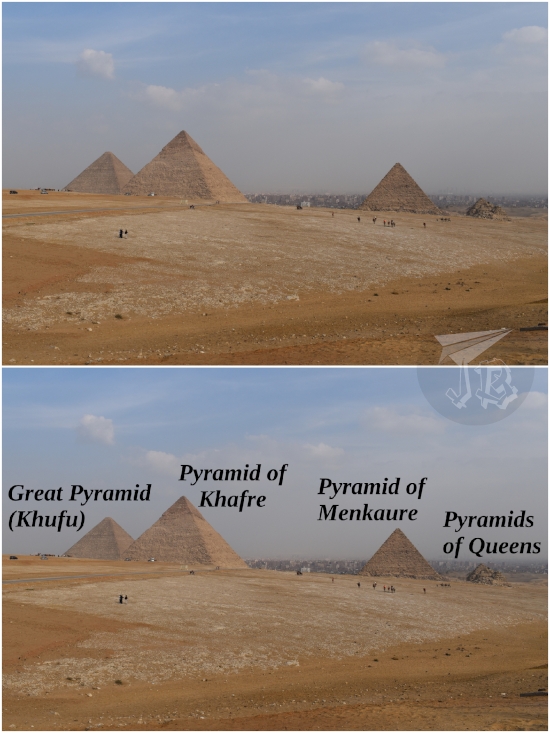
And just like that, it was over, except it was not, because we still had a little while to see the Great Sphinx of Giza [أبو الهول], which is a reclining lion with a human head, made out of limestone. It measures 73 m long and is 20 m high. It is part of the mortuary temple of Khafre, so it is probably his face the Sphinx bears, dating from the 26th century BCE. The Sphinx is currently missing its nose and beard. To access the Sphinx, first we went by the dried up Nile dock and we crossed the Valley Temple of Khafre [معبد الوادي لخفرع]. The temple was built out of megalithic rocks of red granite. The Sphinx was… pretty in a weird way, he had a very pleasant head, despite all the pidgeons.
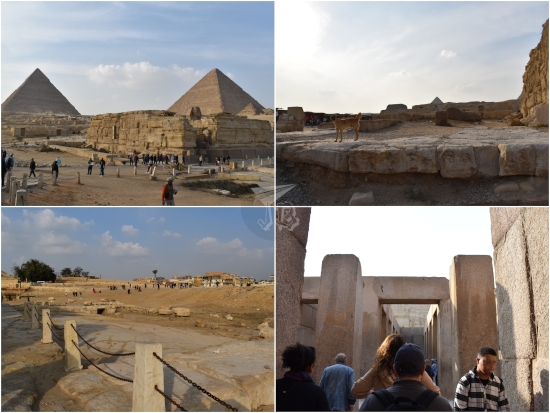

Then, we were driven back into the Cairo chaos to a restaurant for lunch. By this time it was around 15:00, and the menu was fixed. I was highly amused by the fact that the tour guide had tried to up-sell this place as a high-scale seafood restaurant. We were served rice with squid in different ways – breaded and in tomato sauce – three prawns, and fish. The best thing, honestly, was the Egyptian flatbread Aish Baladi [عش بالدي], and the view – after all the name of the restaurant was “Chestro Restaurant Pyramid View” for a reason.
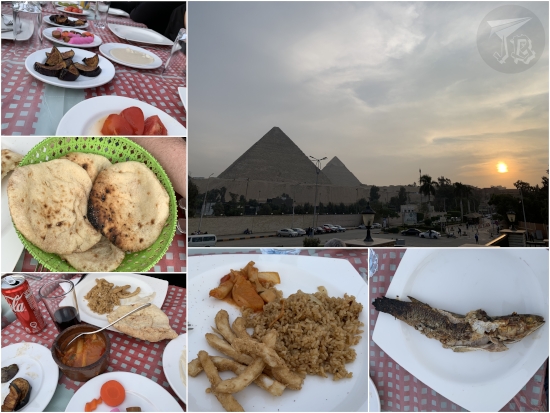
After our very late lunch, we headed off to the last visit of the day – yet another shop. Finally something I was interested in, a place where they had papyruses. Papyruses are made out of the papyrus plant (Nile grass, Cyperus papyrus), a type of flowering sedge. Here, someone explained the process of making the papyrus paper. I found something I liked, a reproduction of Tutankhamun’s jewellery box with a guarding Anubis (currently at the Egyptian Museum in Cairo).

It was around 19:00 when we got back to the hotel, where the tour guide informed us that (the now free) dinner gala would be held from 20:00 to 00:00. We had a bit of a laugh about being so not ready – since nobody had brought any kind of formal clothes as most of us had not booked the dinner – and we arranged to meet at 21:15, since we had finished lunch late. I had a shower, then went downstairs. We met at the agreed time, and spent some time taking pictures, and in the end… we were almost late for dinner! By the time we sat down it was 21:30… and the buffet only ran till 21:45…
Food was not so great, and even less worth 190 €. The singer was terrible, the exotic dancer… was more like a stripper, and I ended up defending all our grapes to the death against overzealous waiters who wanted to clear the table asap. To be fair, it was a nice detail that the tour company got us twelve grapes each to celebrate the New Year’s. Despite the time and quality hiccups, we had a lot of fun. We counted-down to the New Year with the Egyptian time, and one hour later connected to the Spanish TV in order to listen to the bell tolls for midnight and eat our grapes. After saying good night, I had another shower and went to bed, though I could not sleep till the other hotel party finished at 2:30.

It didn’t matter too much though, as the buzz and the high from the pyramid experience kept me content until there was enough silence to zonk out.
